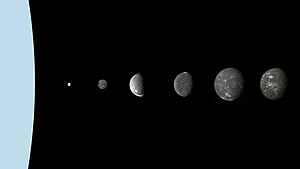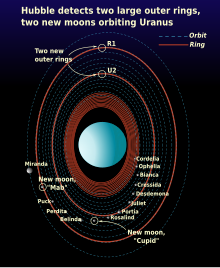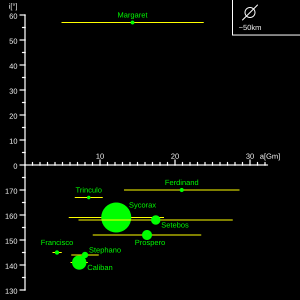 Uranus and its six largest moons compared at their proper relative sizes and relative positions. From left to right: Puck, Miranda, Ariel, Umbriel, Titania and Oberon.
Uranus and its six largest moons compared at their proper relative sizes and relative positions. From left to right: Puck, Miranda, Ariel, Umbriel, Titania and Oberon.Discovery
The first two moons to be discovered, Titania and Oberon, were spotted by Sir William Herschel on January 11, 1787, six years after he had discovered the planet itself. Later, Herschel thought he had discovered up to six moons (see below) and perhaps even a ring. For nearly 50 years, Herschel's instrument was the only one with which the moons had been seen. In the 1840s, better instruments and a more favorable position of Uranus in the sky led to sporadic indications of satellites additional to Titania and Oberon. Eventually, the next two moons, Ariel and Umbriel, were discovered by William Lassell in 1851. The Roman numbering scheme of Uranus's moons was in a state of flux for a considerable time and publications hesitated between Herschel's designations (where Titania and Oberon are Uranus II and IV) and William Lassell's (where they are sometimes I and II). With the confirmation of Ariel and Umbriel, Lassell numbered the moons I through IV from Uranus outward, and this finally stuck. In 1852, Herschel's son John Herschel gave the four then-known moons their names.
No other discoveries were made for almost another century. In 1948, Gerard Kuiper at the McDonald Observatory discovered the smallest and the last of the five large, spherical moons, Miranda. Decades later, the flyby of the Voyager 2 space probe in January 1986 led to the discovery of ten further inner moons. Another satellite, Perdita, was retroactively discovered in 1999 after studying old Voyager photographs.
Uranus was the last giant planet without any known irregular satellites, but since 1997 nine distant irregular moons have been identified using ground-based telescopes. Two more small inner moons, Cupid and Mab, were discovered using the Hubble Space Telescope in 2003. The moon Margaret was the last Uranian moon discovered as of 2008, and its findings were published in October 2003.
Spurious moons
After Herschel discovered Titania and Oberon on January 11, 1787, he subsequently believed that he observed four other moons; two on January 18 and February 9, 1790, and two more on February 28 and March 26, 1794. It was thus believed for many decades thereafter that Uranus had a system of six satellites, though the four latter moons were never confirmed by any other astronomer. Lassell's observations of 1851, in which he discovered Ariel and Umbriel, however, failed to support Herschel's observations; Ariel and Umbriel, which Herschel certainly ought to have seen if he had seen any satellites beside Titania and Oberon, did not correspond to any of Herschel's four additional satellites in orbital characteristics. Herschel's four spurious satellites were thought to have sidereal periods of 5.89 days (interior to Titania), 10.96 days (between Titania and Oberon), 38.08 and 107.69 days (exterior to Oberon). It was therefore concluded that Herschel's four satellites were spurious, probably arising from the misidentification of faint stars in the vicinity of Uranus as satellites, and the credit for the discovery of Ariel and Umbriel was given to Lassell.
Names
The first two Uranian moons, discovered in 1787, did not receive names until 1852, a year after two more moons had been discovered. The responsibility for naming was taken by John Herschel, son of the discoverer of Uranus. Herschel, instead of assigning names from Greek mythology, named the moons after magical spirits in English literature: the fairies Oberon and Titania from William Shakespeare's A Midsummer Night's Dream, and the sylphs Ariel and Umbriel from Alexander Pope's The Rape of the Lock (Ariel is also a sprite in Shakespeare's The Tempest). The reasoning was presumably that Uranus, as god of the sky and air, would be attended by spirits of the air.
Subsequent names, rather than continuing the airy spirits theme (only Puck and Mab continued the trend), have focused on Herschel's source material. In 1949, the fifth moon, Miranda, was named by its discoverer Gerard Kuiper after a thoroughly mortal character in Shakespeare's The Tempest. The current IAU practice is to name moons after characters from Shakespeare's plays and The Rape of the Lock (although at present only Ariel, Umbriel, and Belinda have names drawn from the latter poem; all the rest are from Shakespeare). At first, the outermost moons were all named after characters from one play, The Tempest; but with Margaret being named from Much Ado About Nothing that trend has ended.

The relative masses of the Uranian moons. The five rounded moons vary from Miranda at 0.7% to Titania at almost 40% of the total mass. The other moons collectively constitute 0.1%, and are barely visible at this scale.
The Rape of the Lock (a poem by Alexander Pope):
- Ariel, Umbriel, Belinda
- A Midsummer Night's Dream: Titania, Oberon, Puck
- The Tempest: (Ariel), Miranda, Caliban, Sycorax, Prospero, Setebos, Stephano, Trinculo, Francisco, Ferdinand
- King Lear: Cordelia
- Hamlet: Ophelia
- The Taming of the Shrew: Bianca
- Troilus and Cressida: Cressida
- Othello: Desdemona
- Romeo and Juliet: Juliet, Mab
- The Merchant of Venice: Portia
- As You Like It: Rosalind
- Much Ado About Nothing: Margaret
- The Winter's Tale: Perdita
- Timon of Athens: Cupid
Some asteroids share names with moons of Uranus: 171 Ophelia, 218 Bianca, 593 Titania, 666 Desdemona, 763 Cupido and 2758 Cordelia.
Characteristics and groups

Schematic of the Uranian moon-ring system
Inner moons
As of 2008, Uranus is known to possess 13 inner moons. Their orbits lie inside that of Miranda. All inner moons are intimately connected to the rings of Uranus, which probably resulted from the fragmentation of one or several small inner moons. The two innermost moons (Cordelia and Ophelia) serve as shepherds of Uranus's ε ring, while small moon Mab is a source of Uranus's outermost μ ring.
Puck, at 162 km, is the largest of the inner moons of Uranus and the only one imaged by Voyager 2 in any detail. Puck and Mab are the 2 outermost inner satellites of Uranus. All inner moons are dark objects; their geometrical albedo does not exceed 10%. They are made of water ice contaminated with a dark material—probably radiation processed organics.
The small inner moons constantly perturb each other. The system is chaotic and apparently unstable. Simulations show that the moons may perturb each other into crossing orbits, which may eventually result in collisions between the moons. Desdemona may collide with either Cressida or Juliet within the next 100 million years.
Large moons

The five largest moons of Uranus compared at their proper relative sizes and brightnesses. From left to right (in order of increasing distance from Uranus): Miranda, Ariel, Umbriel, Titania and Oberon.

Artist's conception of the Sun's path in the summer sky of a major moon of Uranus (which shares Uranus' axial tilt)
Extensional processes associated with upwelling diapirs are likely responsible for the origin of the coronae. Ariel appears to have the youngest surface with the fewest impact craters, while Umbriel's appears oldest. A past 3:1 orbital resonance between Miranda and Umbriel and a past 4:1 resonance between Ariel and Titania are thought to be responsible for the heating that caused substantial endogenic activity on Miranda and Ariel. One piece of evidence for such a past resonance is Miranda's unusually high orbital inclination (4.34°) for a body so close to the planet. The largest Uranian moons may be internally differentiated, with rocky cores at their centers surrounded by ice mantles. Titania and Oberon may harbor liquid water oceans at the core/mantle boundary. The major moons of Uranus are airless bodies. For instance, Titania was shown to possess no atmosphere at a pressure larger than 10–20 nanobar.

Orbits of Uranus' five main moons (in green). Uranus' orbit around the Sun is shown in red.
The Sun would appear to follow a circular path around Uranus' celestial pole in the sky, at the closest about 7 degrees away from it. Near the equator, it would be seen nearly due north or due south (depending on the season). At latitudes higher than 7°, the Sun would trace a circular path about 15 degrees diameter in the sky, and never set.
Irregular moons

Irregular moons of Uranus. The X axis is labeled in Gm (million km) and in the fraction of the Hill sphere's radius. The eccentricity is represented by the yellow segments (extending from the pericentre to the apocentre) with the inclination represented on the Y axis.
Uranus's irregular moons range in size from about 150 km (Sycorax) to 18 km (Trinculo). Unlike Jupiter's irregulars, Uranus's show no correlation axis versus inclination. Instead, the retrograde moons can be divided into two groups based on axis/orbital eccentricity. The inner group includes those satellites closer to Uranus (a < 0.15 rH) and moderately eccentric (~0.2), namely Francisco, Caliban, Stephano and Trinculo. The outer group (a > 0.15 rH) includes satellites with high eccentricity (~0.5): Sycorax, Prospero, Setebos and Ferdinand.
The intermediate inclinations 60° < i < 140° are devoid of known moons due to the Kozai instability. In this instability region, solar perturbations at apoapse cause the moons to acquire large eccentricities that lead to collisions with inner satellites or ejection. The lifetime of moons in the instability region is from 10 million to a billion years.
Margaret is the only known irregular prograde moon of Uranus, and it currently has the most eccentric orbit of any moon in the solar system, though Neptune's moon Nereid has a higher mean eccentricity. As of 2008, Margaret's eccentricity is 0.7979.